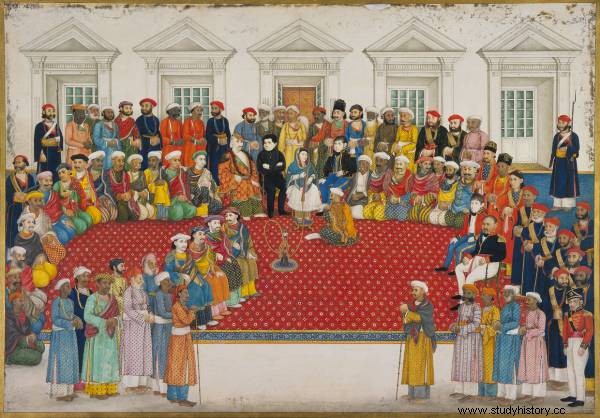Courtesan turned sovereign, La Begum Samru (1750 – 1836) reigned over the principality of Sardhana in India for 58 years. Clever and competent, she manages to maintain the independence of her principality.
Young courtesan
 Daughter of Jaddan Bai and Asad Khan, nobleman, Farzana Khanqui was born around 1750 in Kotana, Uttar Pradesh, a province in northern India. She grew up in the midst of the colonization of the country by the British Empire. She was ten years old when her father died. Asad's son then hunts Farzana and his mother, who go to live in Delhi.
Daughter of Jaddan Bai and Asad Khan, nobleman, Farzana Khanqui was born around 1750 in Kotana, Uttar Pradesh, a province in northern India. She grew up in the midst of the colonization of the country by the British Empire. She was ten years old when her father died. Asad's son then hunts Farzana and his mother, who go to live in Delhi.
Mother and daughter were accommodated in a house in Chauri Bazaar, a district then known for its dancers and courtesans and largely frequented by the British, who were growing in number. Farzana learned the art of dance there, and there met Walter Reinhardt dit Sombre, a general in the service of the Raja of Bharatpur, aged 45. He abandons his concubine – and mother of his son – to settle down with the young girl, who was then only fourteen years old, and more than thirty years his junior.
The jaghir by Sardhana
Mercenary, Walter offers his services to various nobles, then goes to the service of the Mughal emperor. Smart, brave and good at building relationships, Farzana works and fights alongside her. Walter's military prowess, along with that of his troops, earns him the rich jaghir (fiefdom) of Sardhana in 1776. From adventurers, Walter and Farzana, who then became known as the Begum (honorary title given to women of rank) Samru, became rulers.
Walter dies two years later. His son, Zafaryab Khan, should have inherited the jaghir . But Farzana has the support of her husband's troops, who respect her for her intelligence and courage, and the influence at the court of the Mughal emperor Shah Alam II; she obtains Sardhana, and finances for the son of her husband a life in luxury in Delhi.
Zeb ul-nisa
The Begum Samru takes control of the court of Sardhana as well as some 4,000 soldiers of her husband, both sovereign and warlord. Although small in size, she leads her troops into battle and wins several battles.
On several occasions, Farzana flew to the aid of Shah Alam II, by arms or by diplomacy. Thus, in 1783, she obtained through negotiation and the granting of favors the stopping of a siege led by General Baghel Singh. In 1788, she intervened militarily to save the emperor from one of his vassals, Ghulam Qadir. Shah Alam II will eventually call her his "beloved daughter", and give her the title of Zeb ul-nisa (feminine jewel ).
In 1791, Farzana converted to Catholicism and took the name Joanna, possibly in reference to Joan of Arc whom she had heard of. Despite everything, it retains Mughal clothing, customs and etiquette.
A prosperous principality
Several European officers work in the service of Begum Samru. A relationship develops between her and one of them, the French captain Pierre Antoine Le Vassoult. When the rumor of a secret marriage spreads, Farzana's troops revolt. The couple tries to escape. During the escape, Pierre Antoine commits suicide and Farzana is injured in circumstances that remain mysterious, between a gesture of despair or a suicide pact. It was another officer of the Begum, the Irishman George Thomas, who freed her from her rebellious troops and restored her power.
British colonization of India gradually increased. When the Marathi Empire finds itself threatened by the British, Farzana, because of his allegiance to the Mughal Empire, must send battalions. The battle is a heavy defeat, consecrates the advance of the English in India and forces the Begum to surrender. Unlike other principalities, Farzana pulls off an agreement allowing him to keep his principality until his death.

The Begum then devoted himself to the development of his principality. A skilful sovereign, she effectively manages the internal affairs of the kingdom which she makes prosper, promotes arts and culture, builds churches and presbyteries. A visitor will comment as follows:“Her fields look greener and more flourishing and the population of her villages appear happier and more prosperous than those of the East India Company’s provinces. » (Her fields appear greener and more flourishing, and the population of her villages seem happier and more prosperous than those of the East India Company provinces.)
Begum Samru died of illness in January 1836, after 58 years of reign.
